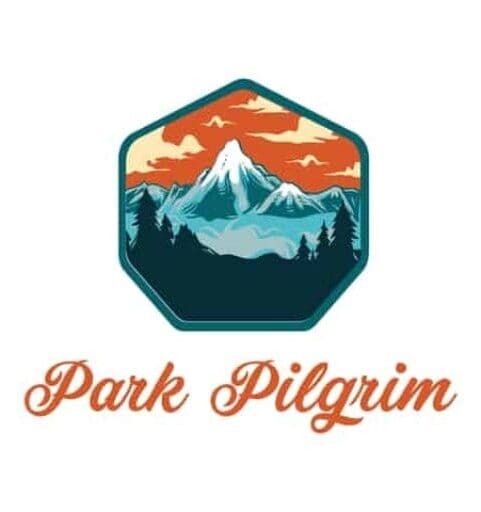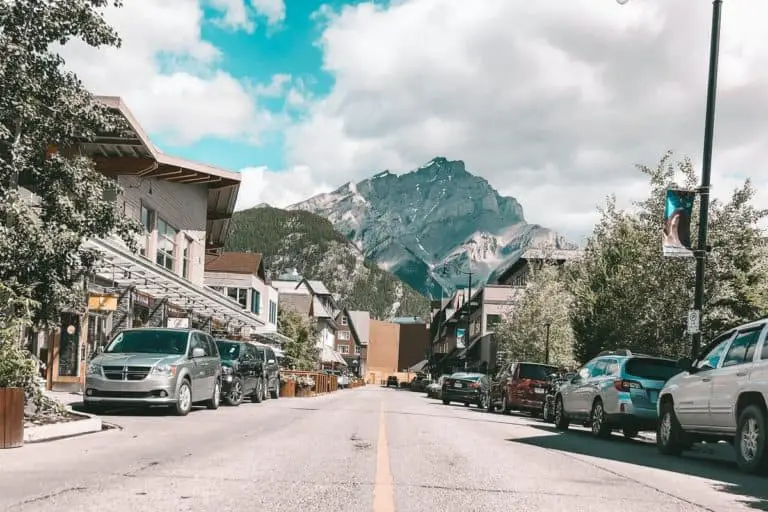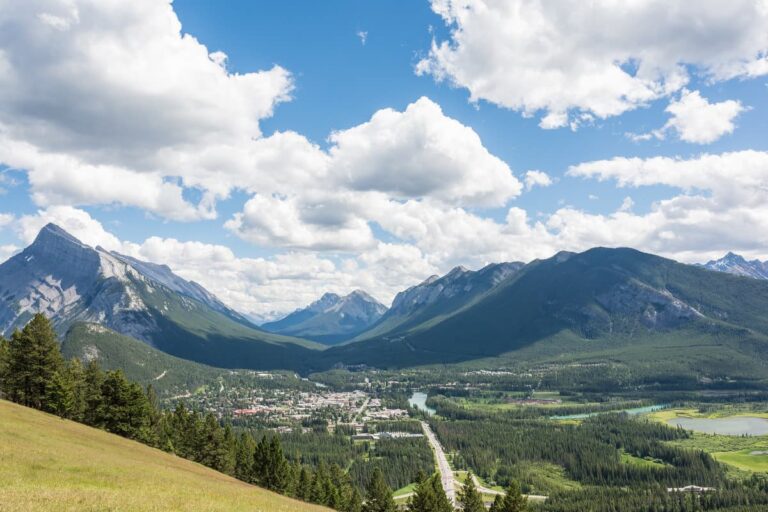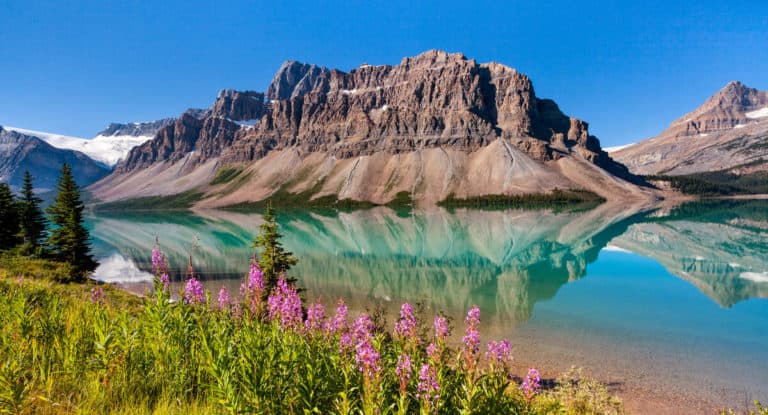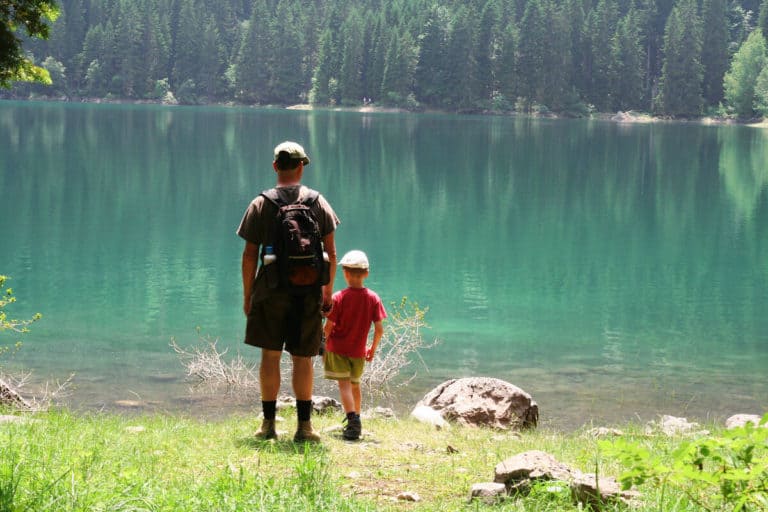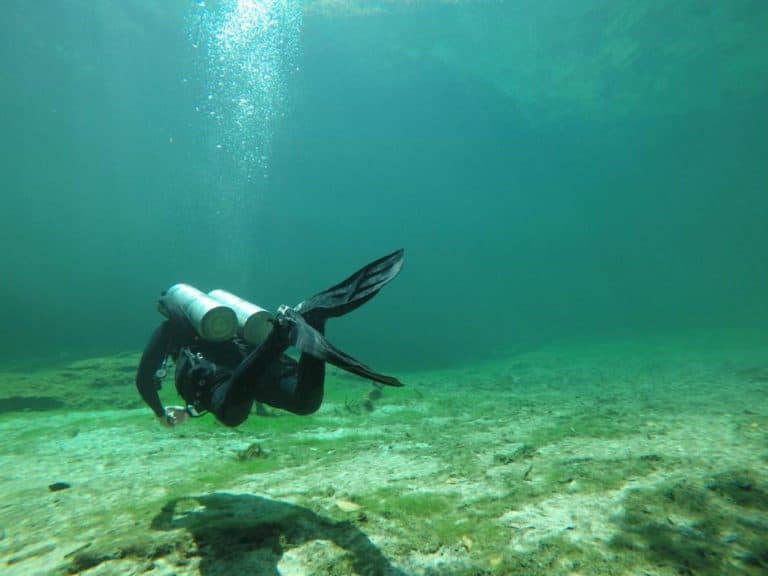Know Your Destination: 26 Valuable Facts About Banff
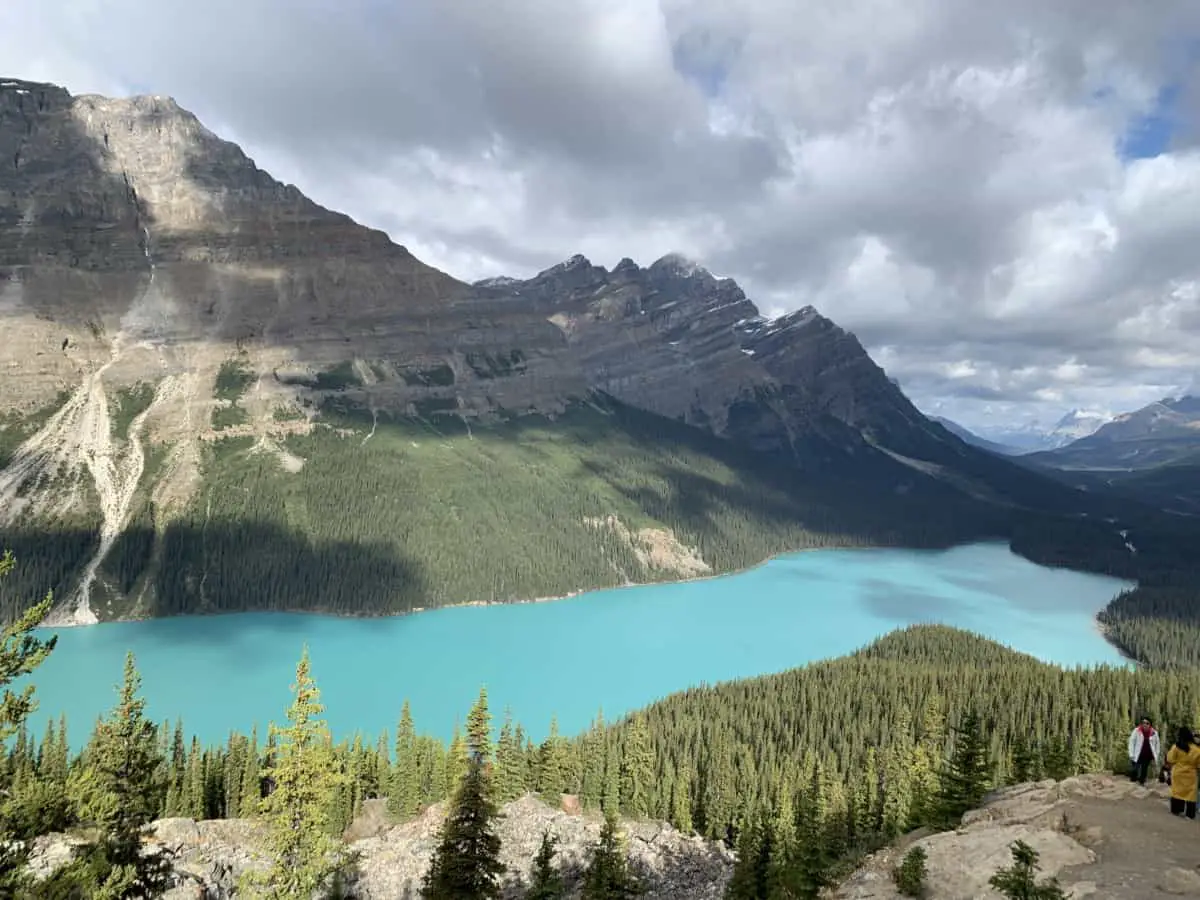
If you have a simple question about Banff, this article might have the answer for you. Below you’ll find answers to frequently asked questions about the park as well as Banff town. Check the table of contents below to see if your question is included.
Where Does the Name Banff Come From?
Banff got its name in 1894 from George Stephen, at the time director of the railroad company Canadian Pacific Railway. He renamed the settlement Banff after his hometown of Banff in Scotland. Until then, this still new settlement in the Rocky Mountains was called Siding 29.
Why Is the Water so Blue in Banff National Park?
The lakes were created by glaciers eroding the land, creating space in the process. The glacier melts in that spot, and the meltwater forms a lake. The eroding action of the glacier pulverizes the minerals in the rock it slides over.
These minerals sink to the lake’s bottom in the form of sediments. When sunlight falls on these sediments (also known as rock flour), they reflect the typical turquoise color for which Lake Louise and Moraine Lake, in particular, are known.
The color of the water appears to be changing in recent years due to climate change. Global warming is causing glaciers to shrink, affecting the color of the water, as was concluded by American biologist Janet Fischer. It means that future generations will probably no longer enjoy the beautiful color of the lakes in Banff National Park.
This change is best seen in the water of Zigadenus Lake, just northeast of Lake Louise. There, the turquoise color is no longer as evident and the color of the water tends more towards “regular” blue.
Can You See the Northern Lights in Banff?
The answer to this question is yes. The province of Alberta in general is an excellent place to observe this remarkable natural phenomenon. This already exceptional experience becomes extra special when you experience it in the wilderness of Banff National Park.
Unfortunately, it is difficult to predict when the northern lights can be seen because it is related to the geomagnetic activity on earth. The best months to observe aurora borealis are from September to April. The light is brightest from February to April on dark and clear nights.
The further away from artificial lights in populated areas, the better you can see the northern lights. Lake Minnewanka, Peyto Lake, and Castle Junction are excellent spots in the park.
You can also observe the dancing green light within walking distance of Banff. Vermilion Lakes is a ten-minute walk from downtown and an excellent location. Should you be in Banff and discover late that the northern lights can be seen, Banff Avenue is a good location to get enchanted by aurora borealis.
TIP: If you want to know more about the northern lights and how to see them in Banff, click the link and read all the ins and outs about this natural phenomenon in the park.
Which Is More Beautiful, Banff or Jasper?
The answer to this question is, of course, heartily subjective. It’s just a matter of what you’re looking for. Many consider the nature of Jasper to be even more rugged than the nature in Banff.
Furthermore, there is a big difference between the towns of Banff and Jasper. Banff is more enclosed in the mountains and looks more “cozy” than Jasper that’s situated in a broad valley. In addition, Banff is much busier than Jasper. Jasper might be the better choice if you don’t like big crowds. If you are looking for vibrant nightlife, you have more options in Banff.
Are Mosquitoes a Nuisance in Banff?
Banff National Park has to deal with many mosquitoes, especially in summer. Around a lake, these insects can be a nuisance. So it’s a good idea to take anti-mosquito spray or some other mosquito repellent with you when you go hiking in the mountains or visit a lake. In the town of Banff the nuisance of mosquitoes is not too bad.
Is Banff Tap Water Potable?
Fortunately, the answer to this question is yes. For many residents of western countries, this question may seem redundant. Still, this question is legitimate for many visitors from other parts of the world.
Banff’s tap water is pumped from a reservoir on Tunnel Mountain. Subsequently, it is disinfected with chlorine. The water is tested daily for quality. In this way, the municipality of Banff ensures that the water meets the standards set by the Guidelines for the Quality of Drinking Water in Canada.
Is it Safe to Drink Lake Water in Banff National Park?
Park manager Parks Canada does not recommend drinking the water in the park’s lakes because of the possible presence of the giardia lamblia. This water-borne parasite can be present in any surface water. Therefore, it is recommended to boil, filter, or chemically treat water from lakes or rivers before drinking it.
At the same time, the glacier water in Banff National Park is among the best quality mineral water in the world. It is rich in minerals because it has flowed over granite, limestone, and sedimentary rock before entering the lake. In Banff the (treated) water is on the menu is in some restaurants.
Does Banff Town Have a Shopping Mall?
Yes, indeed, Banff has several. The largest mall is Cascade Shops. That’s the only one that comes close to the “mall” image that most people will think of. The other malls are basically some stores under the same roof.
- Cascade Shops, 317 Banff Avenue
- Sundance Mall, 215 Banff Avenue
- Clock Tower Village Mall, 108 Banff Avenue
- Bear Street Mall, 226 Bear Street
- Bison Courtyard, 211 Bear Street.
What Is the Closing Time Of the Town of Banff Shops?
Due to the tourist nature of Banff and the large number of tourists in (especially) the summer, stores in Banff are often open until late at night. Some stores do not close until 11 pm.
Is it Customary to Tip in Banff Town?
As in the rest of Canada and the United States, it is customary to tip the staff at restaurants and hotels. For regular service, a tip of 15 percent is normal. If the service is excellent, 20 percent is customary. These percentages pertain to the amount before VAT. If you go lower than 15 percent, let your waiter/waitress know what you disagree with and why.
Is Parking in the Town of Banff Free?
As of 2021, in most places, it is not. Fortunately, some free parking remains, such as the parking lot at Banff’s train station on Railway Avenue. It has room for about 500 vehicles, and you can also park your RV or motorhome there. Parking is free for up to nine hours and on weekends you can get a free shuttle to the center.
You can also park for free in the Bear Street parking garage (187 spaces), except on the first floor of the building, and Bow Avenue (97). These locations also have a 9-hour limit. Another location where you can park for free for short periods is Bear Street. The duration is a maximum of one hour.
If you park in paid parking lots, you pay CAD 3 per hour in the summer (May 1 – October 31). In the winter, you pay CAD 2 per hour. You can pay via the website PaytoParkBanff, the Blinkay app, or at a parking meter.
TIP: If you want to see the current parking situation in Banff at a glance, visit the mobile-friendly website banffparking.ca.
Please note that parking in Banff’s residential areas is not allowed without a permit. If you don’t have a permit visible behind your car’s windshield, you can expect a fine of CAD 55.
I wrote down everything you need to know about parking in Banff National Park. Check it out if you want to know more about what’s up with parking in the park.
Does Banff Town Have Uber?
Banff Town does not have an Uber cab service. On the other hand, Banff has a small area of 3.94 m2 (2.43 mi2), and you can easily reach most locations on foot. If you really do need a cab, you can call Taxi Taxi (+1-403-762-4444 and +1-403-762-0000) and Legion Taxi (+1-403-762-3353).
Can You Travel From Calgary to the Town of Banff by Train?
It is not possible to travel from Calgary to Banff by train. Although both towns have a station, rail carrier Via Rail does not operate passenger trains on this route. However, this is a future option that’s actually being investigated.
Can You Travel by Train from Vancouver to Banff?
It is possible to travel directly from Vancouver to Banff and vice versa. The First Passage to the West route by rail-tour company Rocky Mountaineer gets you to your destination via a stop in Kamloops in British Columbia and Lake Louise in Alberta.
This journey is not a regularly scheduled service and is primarily geared toward tourists. The Rocky Mountaineer provides luxury train travel that focuses on the experience of traveling through the wild nature of British Columbia and Alberta. If you are looking for a connection between Vancouver and Banff, flying to Calgary and then taking the bus to Banff from there is a much faster and cheaper option.
Does Banff Have an Airport?
Banff does indeed have an airport, although runway is a better description. This strip north of Banff is unpaved and only used for emergencies. The code for Banff Airport is (YBA). You’ll find the airstrip off the Trans Canada Highway toward Lake Louise, next to the exit at Tunnel Mountain. Banff Airport is located at 1397 meters (4583 feet). The strip reopened in 2007 after being closed for ten years.
Which Airport Is Closest to Banff?
Although Banff officially has its own airport (YBA, see question above), the nearest proper airport is Calgary International Airport. This airport is 145 kilometers east of Banff.
Can You Get Altitude Sickness in Banff?
Banff is located at an altitude of 1383 meters. This makes it the highest located city in Canada. Nevertheless, you need not fear altitude sickness. People usually only get altitude sickness at about 2400 meters (8000 feet).
Is it Allowed to Build a Campfire in Banff?
Yes, this is allowed. However, you are expected never to leave your campfire unattended. Parks Canada asks people to keep campfires small and let them burn in designated fire pits or bins. Campfires are not allowed between 11 pm, and 7 am. Incidentally, there are times when a blanket fire ban is in effect in the park. This occurs with some regularity in the summer because of forest fires.
Can I Bring My Dog to Banff?
Dogs are welcome in Banff National Park. Many hotels are also accessible to pets. However, they must be on a leash at all times, as required by law. Unleashed dogs can provoke aggressive behavior from bears and other wildlife in the park. So take a leash in your suitcase or backpack for your best friend. By the way, Banff town does allow you to leave your dog unleashed, being the only place in the park.
When Can You Expect Snow in Banff?
In Banff, it can snow any month of the year. So yes, even in July and August. In the mountains, the weather is often inconsistent and unpredictable. So don’t be surprised if you see it snowing in the middle of summer. However, that is and remains an exception. On average, 191 centimeters (75.2 inches) fall in Banff each year. The most snow falls on average in November (31 cm / 12.1 inches) and December (27 cm / 10.8 inches). The least snow falls on average in July and August (o cm / inch).
Can You Ski in Banff in the Summer?
Banff National Park has one of the longest ski seasons in North America. Still, skiing in the summer is unfortunately not possible. The ski season lasts from mid-November through May. For that, you can go to the ski slopes of Mount Norquay, Sunshine Village and the world-famous Lake Louise.
How Old Are the Rocky Mountains in Banff?
The Rocky Mountains were formed from sedimentary rocks pushed eastward over newer rock layers between 80 and 55 million years ago. This period is known as the Laramide orogeny period. During this period the Kula and Farallon plates slid beneath the North American plate. In the process, the Rockies were formed.
When Does it Get Cold in Banff?
The cold season in Banff lasts just over 3 months, formally from November 18 to February 22. The average temperature during this period is below freezing (32°F). The coldest month of the year is December. The average minimum temperature in that month is -14°C (7°F), and the average maximum temperature is -5°C (23°F).
What Is the Highest Mountain in Banff National Park?
The highest mountain in Banff National Park is Mount Assiniboine. This mountain is 3618 meters (11870 feet) high. Because of its unusual piriform shape, it is also called the Matterhorn of the Rockies. By the way, the most significant part of the mountain lies in British Columbia.
The highest mountain that lies entirely in Banff National Park is Mount Forbes. This mountain is only six feet lower than Mount Assiniboine at 3612 meters (11,850 feet).
What’s the Mountain at the End of Banff Avenue Called?
That mountain is Cascade Mountain. It is 2998 meters (9836 feet) high, making it one of the higher mountains in the park. The mountain received its name from James Hector in 1858. This Scottish-New Zealand explorer thought up this name because of the waterfall on its southern flank.
Can I Use a Drone in Banff?
Although it is very tempting to film with a drone in the town of Banff, unfortunately it is not allowed due to several local heliports used for emergencies. These include transport to and from the hospital and firefighting helicopters for forest fires and the like.
This is possible in some cases outside the municipality but within the national park’s boundaries. You need to make arrangements with Transport Canada and Parks Canada for this. If you want to film in Banff National Park, you must apply for a permit. You can obtain one from Parks Canada.
If you get caught using a drone in the park without a permit, you can be prosecuted and face a fine of up to CAD 25,000.
